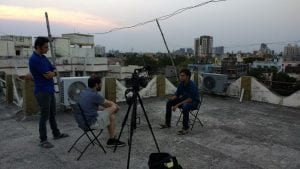UCF History Instructor Explores the Cinema of West Bengal

BY DAVID MORTON
Last summer I embarked on an extraordinary journey into India’s remarkable cinematic past and present. As a passionate enthusiast for international cinema, I was presented with an extraordinary opportunity to go behind the scenes to study one of India’s oldest and internationally prestigious motion picture industries. While many westerners may have at least a passing knowledge of the big-budget spectacles produced out of Mumbai’s Bollywood, a far different style of films are produced on the opposite side of the country. In Kolkata, a quieter and more introspective style of film explores the proclivities of everyday life, the rich literary tradition of the Bengali language and the historical traumas experienced the people of Bengal.
I was given the chance to explore the dimensions of this unique and incredibly personal approach to visual storytelling through a collaboration with Phil Peters, a film professor in the Nicholson School of Communication and Media and the assistance of Subha Das Mollick of the iLead Institute in Kolkata. Over a period of three and half weeks I conducted a series of interviews with leading filmmakers, producers, and critics active in the West Bengal film industry. I also met with historians and experts to discuss Bengali language cinema’s rich historical heritage, and also interviewed up and coming independent filmmakers to learn about the industry’s present and future. 
Known as “The City of Joy,” Kolkata – formerly known as Calcutta – was at one time the capital of India’s British held territories, until the city and region’s strong nationalist sentiment lead to the capital to be relocated to Delhi and the province of Bengal divided into two districts. To this day Kolkata is regarded as the “cultural capital of India,” it is the city of Nobel laureate Rabindranath Tagore – the Bard of Bengal – as well as the center of an intellectual awakening known as the Bengali Renaissance. Nearly everywhere you turn in Kolkata you are surrounded by the essence of the region’s rich literary, artistic, musical and spiritual history. This legacy extends also the pivotal role the city played in the emergence of India’s early film industry and mid-twentieth century prestige. Names such as Satayjit Ray, Rhitwik Ghatak, and Mrinal Sen appear in equal prominence as the region’s iconic folklorists, politicians and spiritual leaders.
In retracing the footsteps of these iconic film legends and learning about the impassioned efforts being made by a new generation of filmmakers, I have crafted together a substantial body of research that I intend to use to connect to my broader research on regional cinemas across the globe. My proposed project, Heroes in the Half Shades: Explorations Into Heroes in the Half Shades: Explorations Into the Lived Experiences of West Bengal Cinema, is the first comprehensive attempt made by a film historian to bridge the past and present of the region’s cinematic culture. In March 2019 I travelled to Seattle, Washington to participate in the annual conference at the Society for Cinema and Media Studies, where my research on the Cinema of West Bengal was featured as part of a special panel on Cinemagoing in a Transnational Context.
Following up on the feedback I received from my presentation and a meticulous review of the hours of interview footage I have compiled, the final outcome of project will be to create a historical survey of Bengali language cinema designed to introduce film students and enthusiasts alike to this unique and fascinating piece of India’s film culture. Currently I am editing the interview footage into a series of mini documentaries that can be used as an educational resource and overseeing the development of an online archive where each interview will be made available to researchers and film fans to learn more about the nature of West Bengali Cinema. The project was sponsored by UCF’s College of Arts and Humanities, the Texts and Technology Ph.D. program, UCF Global, Florida Interactive Entertainment Academy, UCF India Center, Office of Undergraduate Research, School of Visual Arts and Design, Burnett Honors College, Nicholson School of Communication and Media, and UCF Office of Research.
